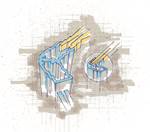Changing The Paradigm
In Gibson’s opinion, large composite structures will be proven onshore, in civil infrastructure. “What will happen is that large pultruded parts and those made with other means will become commonplace,” he maintains, “and then the technology will migrate to other areas, including offshore oil.” Dr. Char
    In Gibson’s opinion, large composite structures will be proven onshore, in civil infrastructure. “What will happen is that large pultruded parts and those made with other means will become commonplace,” he maintains, “and then the technology will migrate to other areas, including offshore oil.”
    Dr. Charles Dolan of the University of Wyoming points out that carbon fiber is an ideal reinforcement for a variety of offshore structures, from lightweight concrete to tendons and prestressed members, because of its durability and lack of corrosion. But designers need to consider the basic differences between carbon fiber and steel, including stiffness and strength.
    “If you limit the sustained stress in fiber reinforced polymer parts to 60 percent of the tensile strength, that gives you 40 percent of the strain and strength capacity in reserve, for overload conditions. If overloaded, the part will recover to near its initial condition because of the elastic response of the fiber reinforcement. Thus, one could argue that FRP is superior to steel because it may be more serviceable after an overload than a steel structure,” explains Dolan. Under extreme conditions, FRP’s elastic response can reduce the potential for catastrophic failure, as well.
    Will composites be more widely used in deepwater structures? According to Doug Johnson of Lincoln Composites (Lincoln, Neb., U.S.A.), the “mind set” is changing. “The predictability and the ability of composites to lower overall platform costs have been proven, thanks to efforts like the Advanced Technology Program under the National Institute of Standards and Technology (NIST),” says Johnson. “Now, we just need time.”
    As water depths and drilling challenges have increased, the performance benefits of composites have indeed gained notice. This trend should continue as the engineering predictability of the materials is proven in additional field tests.
Related Content
-
The potential for thermoplastic composite nacelles
Collins Aerospace draws on global team, decades of experience to demonstrate large, curved AFP and welded structures for the next generation of aircraft.
-
Welding is not bonding
Discussion of the issues in our understanding of thermoplastic composite welded structures and certification of the latest materials and welding technologies for future airframes.
-
Development of a composite liquid hydrogen tank for commercial aircraft
Netherlands consortium advances cryogenic composites testing, tank designs and manufacturing including AFP, hybrid winding, welding of tank components and integrated SHM and H2 sensors for demonstrators in 2025.





